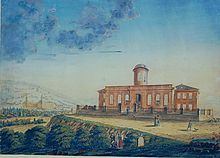Friedrich Bernhard Gottfried Nicolai
Friedrich Bernhard Gottfried Nicolai (born October 25, 1793 in Braunschweig , † June 4, 1846 in Mannheim ) was a German astronomer .
Career
Nicolai came to Göttingen in 1811 and initially studied theology for one semester, but then turned to mathematics. Together with Johann Franz Encke he studied with Carl Friedrich Gauß .
In 1812 he calculated Euler's constant on instructions from Gauss with the help of Euler's empirical formula to 40 decimal places using two independent calculations.
When Bernhard von Lindenau went into the war of liberation, Nicolai was appointed adjunct at the Seeberg observatory near Gotha in 1813 , where he received his training as an astronomer. In the same year he was appointed vice director. He took care of the business of the Seeberg observatory until Lindenau returned. He then worked at the Göttingen observatory with Gauss. There was a cordial relationship between him and Gauss. Nicolai's talent for arithmetic was highly valued everywhere and Gauss, who is otherwise “very poor in praise”, calls him a “iuvenem in calculis perficiendis indefessum”.
Interesting details about the Seeberg observatory can be found in his correspondence with Gauss. Immediately after his arrival, he reported on the conditions during the French invasion of the war in 1813. Initially, they had not discovered the observatory because of the fog. On the second day, however, 30 French stormed the observatory building, looted and driven Lindenau, who had to flee to the city in his dressing gown and slippers.
In another letter he reported on the descriptions that the house servant Hartung gave him of the structure of the observatory. This is how he experienced the huge effort that had to be made just to get a stone base plate for the instrument pillars. A specially built wagon carried them up to the Seeberg in a five-day journey, drawn by dozens of horses and oxen. (The letters are available in the Göttingen University Library).
In 1816 he was appointed professor at the suggestion of Johann Georg von Soldner to the Mannheim observatory . In the spring of 1816, during his visit to the Seeberg observatory, Johann Ludwig Klüber describes the 22-year-old Nicolai as follows:
"The appearance of Mr. Nicolai shows signs of a firm, flourishing health, an alert, cheerful disposition, an active and quickly comprehensible mind."
At the end of March 1818 he visited the Seeberg observatory to observe a comet and the solar eclipse on May 5, 1818 . Since 1821 he was also responsible for collecting meteorological data for the Baden Agricultural Association. In 1822 he married the widow of the Grand Ducal Hessian Colonel Count von Leiningen , Countess Dorothea Franziska von Leiningen. He had four children with her: Karl, August, Amalie and Auguste.
He was friends with the Mannheim court judge and amateur mathematician Conrad von Heiligenstein (1774–1849), they calculated Martian orbits together and set up the logarithmic tables of Adriaan Vlacq and Henry Briggs for practical use.
Until his untimely death he worked as a theoretical and observing astronomer at the observatory. He published his results in the astronomical news published by Heinrich Christian Schumacher .
He died of a stroke in 1846 at the age of 52. His grave is in the main cemetery in Mannheim .
The lunar crater Nicolai was named after him by the IAU in 1935 .
swell
Correspondence between Gauss and Nicolai, manuscript department of the Göttingen University Library
literature
- Siegmund Günther: Nicolai, Friedrich Bernhard Gottfried . In: Allgemeine Deutsche Biographie (ADB). Volume 23, Duncker & Humblot, Leipzig 1886, p. 590 f.
- Heinrich Christian Schumacher : FBG Nicolai. Astronomical News , Volume 25, No. 582, 1847, pp. 91f. bibcode : 1847AN ..... 25 ... 91N .
- Siegmund Günther ADB , Volume 23, p. 590, 1886.
- Kai Budde: Mannheim observatory. The history of the Mannheim observatory 1772–1880. Technology + work. Writings of the State Museum for Technology and Work in Mannheim, Volume 12. Verlag Regionalkultur, Heidelberg 2006.
- Karl Wilhelm Valentiner : Letters from CF Gauss to B. Nicolai. Published on Carl Friedrich Gauss' centenary birthday. Braun, Karlsruhe 1877 (selective, 32 pages).
- Manfred Strumpf: Gotha's astronomical epoch. Geiger, Horb am Neckar 1998, pp. 32-34.
- Poggendorff , Volume 2, p. 283.
Web links
Individual evidence
- ↑ Moon crater Nicolai on astrolink.de
| personal data | |
|---|---|
| SURNAME | Nicolai, Friedrich Bernhard Gottfried |
| BRIEF DESCRIPTION | German astronomer |
| DATE OF BIRTH | October 25, 1793 |
| PLACE OF BIRTH | Braunschweig |
| DATE OF DEATH | June 4, 1846 |
| Place of death | Mannheim |





